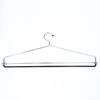- Contact Person : Mr. jiang johnny
- Company Name : Dongguan Qianfu Furniture Manufacturing Co., Ltd.
- Tel : 0086-0769-88322150
- Fax : 0086-0769-88322151
- Address : Guangdong,DongGuan,Huweizhou Industrial Zone, Xiaohe District, Daojiao Town, Dongguan City, Guangdong Province, China.
- Country/Region : China
- Zip : 523181
Related Product Searches:Wire top hanger Metal top hanger,High Quality metal clothes hanger,metal clothes hanger MHY003
Detailed Information About Wire Top Hanger | |
Material | iron,stainless steel,aluminum |
Size | |
Weight | |
Finish | Powder coating ,zinc-plated and as customers request |
Advantage | Provide all kinds of metal clothes hanger Logo hanger,Retail hanger,Hotel hanger With the best workmanship and handcrafting |
Application | Garment,Hotels,Display, Retail industry |
Payment terms | T/T, L/C |
Lead-time | 15-30 days, based on customers order quantity |
Packaging | 100pcs/box |
A clothes hanger, coat hanger or coathanger, is a device in the shape of:
Human shoulders designed to facilitate the hanging of a coat, jacket, sweater, shirt, blouse or dress in a manner that prevents wrinkles, with a lower bar for the hanging of trousers or skirts.Clamp for the hanging of trousers, skirts, or kilts. Both types can be combined in a single hanger.There are three basic types of clothes hangers. The first is the wire hanger, which has a simple loop of wire, most often steel[citation needed], in a flattened triangle shape that continues into a hook at the top. The second is the wooden hanger, which consists of a flat piece of wood cut into a boomerang-like shape with the edges sanded down to prevent damage to the clothing, and a hook, usually of metal, protruding from the point. Some wooden hangers have a rounded bar from tip to tip, forming a flattened triangle. This bar is designed to hang the trousers belonging to the jacket. The third kind and most used in today's world are plastic coat hangers, which mostly mimic the shape of either a wire or wooden hanger. Plastic coat hangers are also produced in smaller sizes to accommodate the shapes of children's clothes.
Some hangers have clips along the bottom for suspending skirts. Dedicated skirt and trousers hangers may not use the triangular shape at all, instead using just a rod with clips. Other hangers have little rings coming from the top two bars to hang straps from tank-tops on. Specialized pant hanger racks may accommodate many pairs of trousers. Foldable clothes hangers that are designed to be inserted through the collar area for ease of use and the reduction of stretching are an old, yet potentially useful variation on traditional clothes hangers. They have been patented over 200 times in the U.S. alone, as in U.S. Patent 0586456, awarded in 1897 to George E. Rideout.
| Contents [hide] 1 History2 In culture3 Unintended uses4 See also5 References |
Some historians believe President Thomas Jefferson invented a forerunner[1] of the wooden clothes hanger.[citation needed]However, today's most used hanger, the shoulder-shaped wire hanger, was inspired by a coat hook that was invented in 1869 by O. A. North of New Britain, Connecticut.[citation needed] An employee of the Timberlake Wire and Novelty Company, Albert J. Parkhouse of Jackson, Michigan has also been credited with the invention.[citation needed], as has Christopher Cann in 1876 as an engineering student at Boston University.
In 1906 Meyer May, a men's clothier of Grand Rapids, Michigan, became the first retailer to display his wares on his wishbone-inspired hangers. Some of these original hangers can be seen at the Frank Lloyd Wright designed Meyer May House in Grand Rapids.
In 1932 Schuyler C. Hulett patented an improved design, which used cardboard tubes mounted on the upper and lower parts of the wire to prevent wrinkles, and in 1935 Elmer D. Rogers added a tube on the lower bar, which is still used.[citation needed]
Hangers can be made in wood, wire, plastic, rarely from rubber substance and other materials. Some are padded with fine materials, such as satin, for expensive clothes, lingerie and fancy dresses. The soft, plush padding is intended to protect garments from shoulder dents that wire hangers may make. A caped hanger is an inexpensive wire clothing hanger covered in paper. Caped hangers are used by dry cleaners to protect garments after cleaning.
[edit]In cultureA wire clothes hanger was also a featured prop in a central scene in the 1981 movie Mommie Dearest, in which Joan Crawford, played by Faye Dunaway, enters the room of her daughter, Christina, at night while the girl sleeps, to admire the beautiful clothes hanging nicely in her closet. She then becomes enraged upon discovering that Christina has used a wire hanger, instead of the expensive padded hangers Joan provided and instructed the girl to use. Joan wakes her daughter and gives her a thrashing. Joan's fierce cry of "No wire hangers, ever!" quickly worked its way into pop culture. Wire clothes hangers play a prominent part in the 2008 movie Birdemic: Shock and Terror. During a key scene in this "Romantic thriller" directed by James Nguyen, four terrified characters defend themselves against bloodthirsty hawks and vultures by waving wire hangers over their heads in the parking lot of a San Francisco Bay Area Motel 6.
Commonly used as an implement for roasting marshmallows or hot dogs at camp-outs.
Unfolded wire clothes hangers, because of their use in performing illegal or self-induced abortions (by inserting one in the uterus), have been used forpro-choice protest.[2]
[edit]Unintended usesWire is versatile, and wire clothes hangers are often used as cheap sources of semi-tough wire, more available than baling wire for all sorts of home projects. The use of wire clothes hangers for use as makeshift welding rod has been common for nearly 100 years. Similarly, many similar do-it-yourselfand children's projects use wire hangers as holders of various types, from keeping a brake caliper from hanging by the brake line during auto repair work, to securing a gate on a bird cage. After sanding, wire hangers also find uses as conducting wire for uses as varied as hot wiring cars to games [3] to testing hand steadiness. They are commonly used to gain forcible entry into older automobiles whose locks and entry systems are not protected from such methods. There is a long history of using wire coat hangers as replacement car radio antennas.
Collecticus magazine reported in October 2007 that clothes hangers have now become collectible, especially those with a famous company or event advertised across the front. For example, a 1950 Butlins hanger sold for £10.10 in October 2006 within Collecticus.
In 1995, Professor Angus Wallace used an unfolded coathanger, sterilised with brandy, to perform emergency surgery on the collapsed lung of Paula Dixon in an airliner at 35,000 feet.[4]








